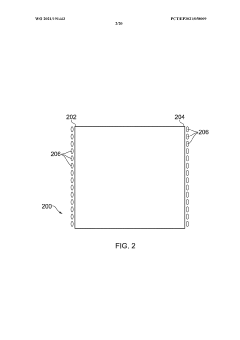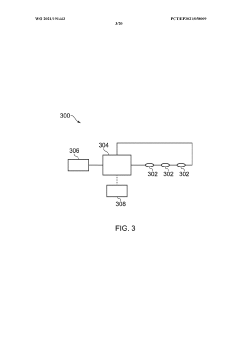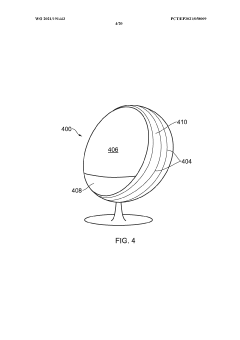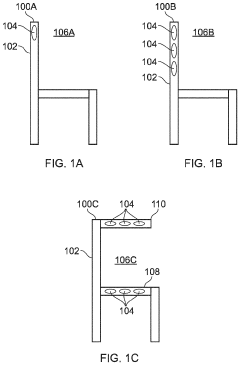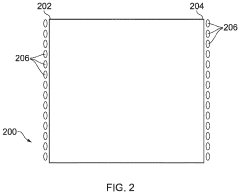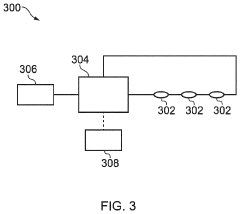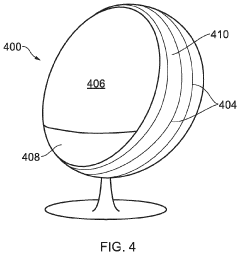How to Evaluate Schumann Resonance Influences on Technology?
JUN 24, 20258 MIN READ
Generate Your Research Report Instantly with AI Agent
Patsnap Eureka helps you evaluate technical feasibility & market potential.
Schumann Resonance Background and Research Objectives
The Schumann resonance, discovered by physicist Winfried Otto Schumann in 1952, is a set of spectrum peaks in the extremely low frequency (ELF) portion of the Earth's electromagnetic field spectrum. These resonances occur between the Earth's surface and the ionosphere, creating a global electromagnetic resonance phenomenon. The fundamental frequency of Schumann resonance is approximately 7.83 Hz, with harmonics at higher frequencies.
Over the years, research into Schumann resonance has evolved from purely geophysical studies to investigations of its potential impacts on various technological systems and human health. The growing interest in this phenomenon stems from its ubiquitous nature and the increasing electromagnetic sensitivity of modern technologies.
The primary objective of evaluating Schumann resonance influences on technology is to understand how these natural electromagnetic oscillations interact with artificial electromagnetic systems. This research aims to identify potential interference patterns, performance impacts, and opportunities for harnessing or mitigating these effects in technological applications.
Key areas of investigation include the influence of Schumann resonance on communication systems, particularly those operating in the ELF range, such as submarine communications and some long-range radio systems. Additionally, researchers are exploring its potential effects on sensitive electronic equipment, including medical devices and precision instruments.
Another significant aspect of this research is the exploration of Schumann resonance as a potential energy source or carrier for novel technologies. Some studies suggest that it could be utilized in wireless power transmission or as a global timing reference for certain applications.
The evaluation of Schumann resonance influences also extends to its potential impact on emerging technologies like quantum computing and nanotechnology, where electromagnetic sensitivities can be particularly acute. Understanding these interactions could lead to the development of more robust and efficient systems in these cutting-edge fields.
As global reliance on wireless technologies continues to grow, the importance of comprehending and potentially leveraging Schumann resonance becomes increasingly relevant. This research not only aims to mitigate potential negative impacts but also to explore innovative ways to integrate this natural phenomenon into future technological advancements.
Over the years, research into Schumann resonance has evolved from purely geophysical studies to investigations of its potential impacts on various technological systems and human health. The growing interest in this phenomenon stems from its ubiquitous nature and the increasing electromagnetic sensitivity of modern technologies.
The primary objective of evaluating Schumann resonance influences on technology is to understand how these natural electromagnetic oscillations interact with artificial electromagnetic systems. This research aims to identify potential interference patterns, performance impacts, and opportunities for harnessing or mitigating these effects in technological applications.
Key areas of investigation include the influence of Schumann resonance on communication systems, particularly those operating in the ELF range, such as submarine communications and some long-range radio systems. Additionally, researchers are exploring its potential effects on sensitive electronic equipment, including medical devices and precision instruments.
Another significant aspect of this research is the exploration of Schumann resonance as a potential energy source or carrier for novel technologies. Some studies suggest that it could be utilized in wireless power transmission or as a global timing reference for certain applications.
The evaluation of Schumann resonance influences also extends to its potential impact on emerging technologies like quantum computing and nanotechnology, where electromagnetic sensitivities can be particularly acute. Understanding these interactions could lead to the development of more robust and efficient systems in these cutting-edge fields.
As global reliance on wireless technologies continues to grow, the importance of comprehending and potentially leveraging Schumann resonance becomes increasingly relevant. This research not only aims to mitigate potential negative impacts but also to explore innovative ways to integrate this natural phenomenon into future technological advancements.
Market Analysis for Schumann Resonance Applications
The market for Schumann Resonance applications is experiencing significant growth as researchers and industries explore its potential impacts on technology and human health. The global market for electromagnetic field (EMF) detection and measurement devices, which includes Schumann Resonance monitoring equipment, is projected to expand steadily over the next decade. This growth is driven by increasing awareness of electromagnetic pollution and its potential effects on human well-being and technological systems.
In the telecommunications sector, there is growing interest in understanding how Schumann Resonances might affect signal propagation and wireless communication technologies. As 5G networks continue to roll out globally, companies are investing in research to evaluate potential interactions between these ultra-low frequency natural electromagnetic waves and artificial electromagnetic fields generated by communication infrastructure.
The aerospace industry is another key market for Schumann Resonance applications. Space agencies and satellite manufacturers are exploring how these resonances might impact satellite communications and navigation systems. There is also ongoing research into the potential use of Schumann Resonances for long-distance communication in space exploration missions.
In the healthcare and wellness sector, there is a growing market for devices that claim to harness or mimic Schumann Resonances for therapeutic purposes. While scientific evidence supporting these claims remains limited, consumer interest in natural healing modalities has fueled demand for such products. This niche market includes wearable devices, sleep aids, and meditation tools designed to synchronize users with Earth's natural frequencies.
The environmental monitoring and geophysics sectors represent another significant market opportunity. As climate change concerns grow, there is increased demand for sophisticated monitoring systems that can detect subtle changes in the Earth's electromagnetic environment. Schumann Resonance monitoring stations are being integrated into global networks for studying ionospheric dynamics and potential correlations with seismic activity or extreme weather events.
In the realm of quantum technologies, researchers are exploring potential applications of Schumann Resonances in quantum sensing and communication. While still in early stages, this field could open up new market opportunities in the future, particularly in areas such as ultra-sensitive magnetometry and secure long-distance quantum communication protocols.
Overall, the market for Schumann Resonance applications is diverse and expanding. As research in this field progresses, new technological applications and market opportunities are likely to emerge, driving further growth and innovation across multiple industries.
In the telecommunications sector, there is growing interest in understanding how Schumann Resonances might affect signal propagation and wireless communication technologies. As 5G networks continue to roll out globally, companies are investing in research to evaluate potential interactions between these ultra-low frequency natural electromagnetic waves and artificial electromagnetic fields generated by communication infrastructure.
The aerospace industry is another key market for Schumann Resonance applications. Space agencies and satellite manufacturers are exploring how these resonances might impact satellite communications and navigation systems. There is also ongoing research into the potential use of Schumann Resonances for long-distance communication in space exploration missions.
In the healthcare and wellness sector, there is a growing market for devices that claim to harness or mimic Schumann Resonances for therapeutic purposes. While scientific evidence supporting these claims remains limited, consumer interest in natural healing modalities has fueled demand for such products. This niche market includes wearable devices, sleep aids, and meditation tools designed to synchronize users with Earth's natural frequencies.
The environmental monitoring and geophysics sectors represent another significant market opportunity. As climate change concerns grow, there is increased demand for sophisticated monitoring systems that can detect subtle changes in the Earth's electromagnetic environment. Schumann Resonance monitoring stations are being integrated into global networks for studying ionospheric dynamics and potential correlations with seismic activity or extreme weather events.
In the realm of quantum technologies, researchers are exploring potential applications of Schumann Resonances in quantum sensing and communication. While still in early stages, this field could open up new market opportunities in the future, particularly in areas such as ultra-sensitive magnetometry and secure long-distance quantum communication protocols.
Overall, the market for Schumann Resonance applications is diverse and expanding. As research in this field progresses, new technological applications and market opportunities are likely to emerge, driving further growth and innovation across multiple industries.
Current Challenges in Schumann Resonance Detection
The detection of Schumann resonances presents several significant challenges that researchers and technologists must overcome to accurately evaluate their influence on technology. One of the primary obstacles is the extremely low frequency and amplitude of these signals, typically ranging from 7.83 Hz to about 60 Hz, with amplitudes in the picoTesla range. This low-intensity nature makes them susceptible to interference from various natural and artificial sources, including geomagnetic disturbances, lightning activity, and human-generated electromagnetic noise.
The global nature of Schumann resonances adds another layer of complexity to their detection. As these resonances occur in the Earth-ionosphere cavity, their characteristics can vary depending on the geographical location of the measurement. This variability necessitates a network of globally distributed sensors to accurately capture and analyze the resonances, presenting logistical and financial challenges for comprehensive studies.
Furthermore, the dynamic nature of the Earth's ionosphere, which forms the upper boundary of the resonant cavity, introduces additional complications. Ionospheric conditions fluctuate due to solar activity, seasonal changes, and diurnal variations, directly affecting the properties of Schumann resonances. These fluctuations require long-term, continuous monitoring to distinguish between natural variations and potential technological influences.
The interdisciplinary nature of Schumann resonance research also poses challenges in terms of expertise and collaboration. Effective evaluation requires knowledge spanning atmospheric physics, electromagnetics, signal processing, and potentially fields such as biology and psychology when considering potential impacts on living systems. Bridging these diverse areas of expertise can be challenging but is crucial for comprehensive analysis.
Technical limitations in sensor technology and data processing also contribute to the challenges. Developing sensors capable of detecting such weak signals with high precision, while filtering out noise and interference, remains an ongoing area of research. Additionally, processing and interpreting the vast amounts of data generated by continuous monitoring requires advanced algorithms and computational resources.
Lastly, the potential subtle and long-term effects of Schumann resonances on technology and biological systems necessitate extended study periods and carefully designed experiments. Isolating the specific influences of these resonances from other environmental factors requires meticulous experimental design and control, further complicating the evaluation process.
The global nature of Schumann resonances adds another layer of complexity to their detection. As these resonances occur in the Earth-ionosphere cavity, their characteristics can vary depending on the geographical location of the measurement. This variability necessitates a network of globally distributed sensors to accurately capture and analyze the resonances, presenting logistical and financial challenges for comprehensive studies.
Furthermore, the dynamic nature of the Earth's ionosphere, which forms the upper boundary of the resonant cavity, introduces additional complications. Ionospheric conditions fluctuate due to solar activity, seasonal changes, and diurnal variations, directly affecting the properties of Schumann resonances. These fluctuations require long-term, continuous monitoring to distinguish between natural variations and potential technological influences.
The interdisciplinary nature of Schumann resonance research also poses challenges in terms of expertise and collaboration. Effective evaluation requires knowledge spanning atmospheric physics, electromagnetics, signal processing, and potentially fields such as biology and psychology when considering potential impacts on living systems. Bridging these diverse areas of expertise can be challenging but is crucial for comprehensive analysis.
Technical limitations in sensor technology and data processing also contribute to the challenges. Developing sensors capable of detecting such weak signals with high precision, while filtering out noise and interference, remains an ongoing area of research. Additionally, processing and interpreting the vast amounts of data generated by continuous monitoring requires advanced algorithms and computational resources.
Lastly, the potential subtle and long-term effects of Schumann resonances on technology and biological systems necessitate extended study periods and carefully designed experiments. Isolating the specific influences of these resonances from other environmental factors requires meticulous experimental design and control, further complicating the evaluation process.
Existing Methods for Evaluating Schumann Resonance Effects
01 Electromagnetic field generation devices
Various devices are designed to generate electromagnetic fields that mimic or interact with the Schumann resonance. These devices aim to create beneficial effects on human health and well-being by simulating the natural electromagnetic environment of the Earth.- Therapeutic applications of Schumann resonance: Schumann resonance is utilized in various therapeutic applications, including stress reduction, improved sleep quality, and overall well-being. Devices and methods are developed to generate or simulate Schumann resonance frequencies for health benefits.
- Environmental monitoring and prediction: Schumann resonance is used in environmental monitoring systems to detect and predict natural phenomena such as earthquakes, thunderstorms, and ionospheric disturbances. These systems analyze changes in Schumann resonance patterns to provide early warnings and improve weather forecasting.
- Electromagnetic shielding and protection: Innovations in electromagnetic shielding incorporate Schumann resonance principles to protect electronic devices and living organisms from harmful electromagnetic radiation. These solutions aim to maintain the beneficial effects of natural electromagnetic fields while blocking artificial interference.
- Communication and navigation systems: Schumann resonance is applied in the development of long-range communication systems and navigation technologies. These applications utilize the Earth's ionosphere as a waveguide for signal transmission, improving global communication capabilities and navigation accuracy.
- Energy harvesting and wireless power transfer: Researchers are exploring the potential of Schumann resonance for energy harvesting and wireless power transfer applications. These innovations aim to tap into the Earth's natural electromagnetic field as a sustainable energy source for powering low-energy devices and sensors.
02 Therapeutic applications of Schumann resonance
Schumann resonance is utilized in therapeutic applications, including stress reduction, improved sleep quality, and overall health enhancement. Devices and methods are developed to expose individuals to frequencies matching or harmonizing with the Schumann resonance for potential health benefits.Expand Specific Solutions03 Integration with wearable technology
Wearable devices incorporating Schumann resonance technology are being developed. These devices aim to provide continuous exposure to beneficial electromagnetic frequencies, potentially improving the wearer's well-being and physiological balance throughout daily activities.Expand Specific Solutions04 Environmental and architectural applications
Schumann resonance principles are being applied in environmental design and architecture. This includes the development of living spaces, work environments, and public areas that incorporate technologies to generate or enhance natural electromagnetic fields, potentially creating more harmonious and health-promoting environments.Expand Specific Solutions05 Research and measurement tools
Specialized equipment and methodologies are being developed for researching and measuring Schumann resonance and its effects. These tools aim to provide more accurate data on the Earth's electromagnetic environment and its potential influences on various biological and ecological systems.Expand Specific Solutions
Key Players in Schumann Resonance Technology
The evaluation of Schumann Resonance influences on technology is an emerging field, currently in its early developmental stages. The market size is relatively small but growing, as more industries recognize the potential impact of these low-frequency electromagnetic waves on various technologies. The technological maturity is still evolving, with companies like FUJIFILM Corp., Schlumberger Technologies, Inc., and Canon, Inc. leading research efforts. Universities such as The Chinese University of Hong Kong and the University of Bern are contributing significantly to the academic understanding. The competitive landscape is diverse, with both established tech giants and specialized research institutions vying for breakthroughs in harnessing or mitigating Schumann Resonance effects on electronic systems, communications, and potentially health-related technologies.
Canon, Inc.
Technical Solution: Canon has developed innovative imaging technologies that leverage Schumann resonance patterns for enhanced geophysical surveying and environmental monitoring. Their approach combines high-sensitivity electromagnetic sensors with advanced image processing algorithms to visualize subtle variations in the Earth's electromagnetic field. This technology allows for non-invasive subsurface mapping and can potentially detect geological anomalies or environmental changes that may affect technological infrastructure.
Strengths: Novel application of Schumann resonances in imaging technology. Weaknesses: May have limited direct relevance to evaluating technological impacts.
Koninklijke Philips NV
Technical Solution: Philips has integrated Schumann resonance considerations into their medical device development process. They have created specialized shielding and filtering techniques to mitigate potential interference from Schumann resonances on sensitive medical equipment. Their approach includes comprehensive electromagnetic compatibility (EMC) testing that specifically accounts for the frequency range of Schumann resonances, ensuring their medical devices remain accurate and reliable under various electromagnetic conditions.
Strengths: Direct application to medical technology, enhancing device reliability. Weaknesses: Focus may be limited to medical sector, potentially overlooking other technological domains.
Critical Patents in Schumann Resonance Measurement
A magnetic field exposure system and uses thereof
PatentWO2021191443A1
Innovation
- A magnetic field exposure system generating an amplitude-modulated low frequency magnetic field with a carrier frequency of 360 to 450 Hz and a modulation frequency of 0.5 to 100 Hz, with a field strength of 0.5 to 250 mT, specifically designed to expose organic cells or tissues to improve cell survival, proliferation, reduce stress, and enhance well-being.
A magnetic field exposure system and uses thereof
PatentPendingUS20230372726A1
Innovation
- A magnetic field exposure system generating an amplitude-modulated low frequency magnetic field with a carrier frequency of 360 to 450 Hz and a modulation frequency of 0.5 to 100 Hz, providing a field strength of 0.5 to 250 μT, specifically designed to enhance cell survival, proliferation, reduce stress, and promote tissue regeneration.
Electromagnetic Compatibility Considerations
Electromagnetic compatibility (EMC) is a critical consideration when evaluating the influence of Schumann resonances on technology. These natural electromagnetic oscillations, occurring at frequencies between 7.83 Hz and 60 Hz, can potentially interfere with electronic devices and systems. To ensure reliable operation of technology in the presence of Schumann resonances, comprehensive EMC testing and mitigation strategies must be implemented.
One key aspect of EMC evaluation is identifying susceptible components within technological systems. Sensitive analog circuits, low-frequency amplifiers, and long signal lines are particularly vulnerable to Schumann resonance interference. Engineers must conduct thorough susceptibility analyses to pinpoint these weak points and develop appropriate shielding or filtering solutions.
Shielding techniques play a crucial role in mitigating Schumann resonance effects. Faraday cages, conductive enclosures, and metalized coatings can be employed to attenuate electromagnetic fields and protect sensitive electronics. However, the effectiveness of shielding at extremely low frequencies (ELF) poses unique challenges, requiring careful design and material selection to achieve optimal results.
Filtering is another essential EMC strategy for managing Schumann resonance influences. Low-pass, high-pass, or notch filters can be implemented to suppress specific frequency components associated with these resonances. The design of such filters must balance the need for interference rejection with minimal impact on desired signal integrity.
Grounding and bonding practices are critical for maintaining EMC in the presence of Schumann resonances. Proper grounding techniques help dissipate induced currents and minimize potential differences between system components. Engineers must carefully consider ground loop avoidance and implement star-point grounding where appropriate to reduce the impact of low-frequency electromagnetic disturbances.
EMC testing protocols must be adapted to account for the unique characteristics of Schumann resonances. Standard EMC test procedures may not adequately capture the effects of these low-frequency phenomena. Specialized test setups, including large-scale anechoic chambers or open-area test sites, may be necessary to accurately simulate and measure Schumann resonance influences on technology.
Compliance with relevant EMC standards and regulations is essential when evaluating Schumann resonance effects. While many existing standards focus on higher frequency ranges, there is a growing recognition of the need to address ELF electromagnetic compatibility. Engineers must stay informed about evolving regulatory requirements and industry best practices in this area.
One key aspect of EMC evaluation is identifying susceptible components within technological systems. Sensitive analog circuits, low-frequency amplifiers, and long signal lines are particularly vulnerable to Schumann resonance interference. Engineers must conduct thorough susceptibility analyses to pinpoint these weak points and develop appropriate shielding or filtering solutions.
Shielding techniques play a crucial role in mitigating Schumann resonance effects. Faraday cages, conductive enclosures, and metalized coatings can be employed to attenuate electromagnetic fields and protect sensitive electronics. However, the effectiveness of shielding at extremely low frequencies (ELF) poses unique challenges, requiring careful design and material selection to achieve optimal results.
Filtering is another essential EMC strategy for managing Schumann resonance influences. Low-pass, high-pass, or notch filters can be implemented to suppress specific frequency components associated with these resonances. The design of such filters must balance the need for interference rejection with minimal impact on desired signal integrity.
Grounding and bonding practices are critical for maintaining EMC in the presence of Schumann resonances. Proper grounding techniques help dissipate induced currents and minimize potential differences between system components. Engineers must carefully consider ground loop avoidance and implement star-point grounding where appropriate to reduce the impact of low-frequency electromagnetic disturbances.
EMC testing protocols must be adapted to account for the unique characteristics of Schumann resonances. Standard EMC test procedures may not adequately capture the effects of these low-frequency phenomena. Specialized test setups, including large-scale anechoic chambers or open-area test sites, may be necessary to accurately simulate and measure Schumann resonance influences on technology.
Compliance with relevant EMC standards and regulations is essential when evaluating Schumann resonance effects. While many existing standards focus on higher frequency ranges, there is a growing recognition of the need to address ELF electromagnetic compatibility. Engineers must stay informed about evolving regulatory requirements and industry best practices in this area.
Potential Health Implications of Schumann Resonance
The potential health implications of Schumann Resonance have garnered increasing attention in recent years, as researchers explore the relationship between these natural electromagnetic frequencies and human well-being. Schumann Resonances, discovered by physicist Winfried Otto Schumann in 1952, are global electromagnetic resonances generated and excited by lightning discharges in the cavity formed by the Earth's surface and the ionosphere.
Several studies have suggested that exposure to Schumann Resonances may have beneficial effects on human health. Some researchers propose that these frequencies, particularly the fundamental frequency of approximately 7.83 Hz, may synchronize with human brainwaves and potentially influence various physiological processes. This alignment could potentially contribute to improved sleep patterns, reduced stress levels, and enhanced overall well-being.
Furthermore, some investigations have indicated that Schumann Resonances might play a role in regulating circadian rhythms and melatonin production. This connection could have implications for sleep quality and the body's natural healing processes. Additionally, there is speculation that these resonances may influence the human immune system, potentially enhancing its function and resilience against various health challenges.
However, it is crucial to note that the scientific evidence supporting these health claims remains limited and often controversial. Many studies in this field are preliminary or lack robust methodological designs, making it challenging to draw definitive conclusions about the direct health impacts of Schumann Resonances.
As technology continues to advance, there is growing concern about the potential interference of artificial electromagnetic fields with natural Schumann Resonances. Some researchers hypothesize that this interference could disrupt the body's natural electromagnetic balance, potentially leading to adverse health effects. However, more research is needed to fully understand the implications of this interaction and its impact on human health.
In conclusion, while the potential health implications of Schumann Resonances are intriguing, further rigorous scientific investigation is necessary to establish clear causal relationships and validate the proposed health benefits. As research in this field progresses, it may provide valuable insights into the complex interplay between natural electromagnetic phenomena and human health, potentially opening new avenues for technological applications in healthcare and well-being.
Several studies have suggested that exposure to Schumann Resonances may have beneficial effects on human health. Some researchers propose that these frequencies, particularly the fundamental frequency of approximately 7.83 Hz, may synchronize with human brainwaves and potentially influence various physiological processes. This alignment could potentially contribute to improved sleep patterns, reduced stress levels, and enhanced overall well-being.
Furthermore, some investigations have indicated that Schumann Resonances might play a role in regulating circadian rhythms and melatonin production. This connection could have implications for sleep quality and the body's natural healing processes. Additionally, there is speculation that these resonances may influence the human immune system, potentially enhancing its function and resilience against various health challenges.
However, it is crucial to note that the scientific evidence supporting these health claims remains limited and often controversial. Many studies in this field are preliminary or lack robust methodological designs, making it challenging to draw definitive conclusions about the direct health impacts of Schumann Resonances.
As technology continues to advance, there is growing concern about the potential interference of artificial electromagnetic fields with natural Schumann Resonances. Some researchers hypothesize that this interference could disrupt the body's natural electromagnetic balance, potentially leading to adverse health effects. However, more research is needed to fully understand the implications of this interaction and its impact on human health.
In conclusion, while the potential health implications of Schumann Resonances are intriguing, further rigorous scientific investigation is necessary to establish clear causal relationships and validate the proposed health benefits. As research in this field progresses, it may provide valuable insights into the complex interplay between natural electromagnetic phenomena and human health, potentially opening new avenues for technological applications in healthcare and well-being.
Unlock deeper insights with Patsnap Eureka Quick Research — get a full tech report to explore trends and direct your research. Try now!
Generate Your Research Report Instantly with AI Agent
Supercharge your innovation with Patsnap Eureka AI Agent Platform!

